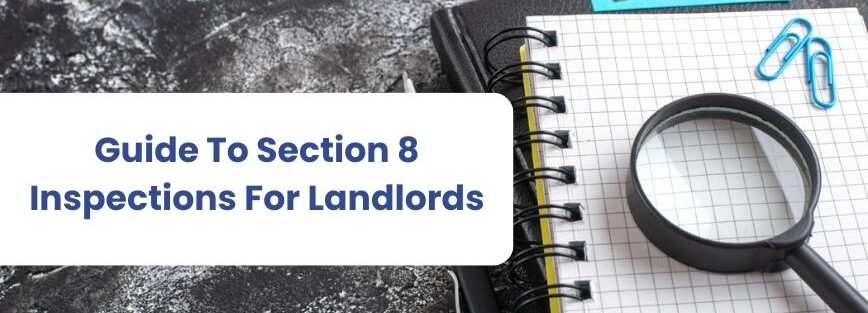In the world of real estate, Section 8 is a significant program that provides housing assistance to millions of households across the United States. For landlords, participating in the Section 8 program can be financially rewarding, but it comes with certain responsibilities, including the necessity of passing Section 8 inspections.
In this article, we will provide a detailed overview of Section 8 inspections, including their frequency, conducting parties, and the consequences of failing an inspection. We will also offer a comprehensive Section 8 inspection checklist for 2022.
How Often Does HUD Do Inspections?
HUD Section 8 inspections occur in several scenarios, including:
Initial Inspection/Move-In Inspection: This is required before a HUD voucher holder can sign a lease and receive housing assistance payments (HAPs). While these inspections are less stringent, they are vital. Ensuring the unit is vacant and powered up is essential before the inspection.
Annual Inspection: Conducted annually, these are typically more thorough and are often scheduled well in advance. However, some PHAs may conduct inspections every two years due to budget constraints.
Special Inspections: These surprise audits are in response to complaints, often from neighbors, residents, or landlords themselves, but they can also happen as random checks for compliance.
Lending-Related Inspections: Additional inspections may be required for properties seeking financing related to the Section 8 program, such as HUD multifamily loans or certain Fannie Mae and Freddie Mac multifamily loan products.
Does Section 8 Do Random Inspections?
Section 8 inspections are not typically random. They occur when a complaint is filed with the Public Housing Authority (PHA).
Who Conducts a Section 8 Inspection?
Section 8 inspections are usually conducted by third-party inspection firms hired by the local PHA. In some cases, larger PHAs may have an in-house inspection team.
What is a HUD REAC Inspection, and What Are the HUD Housing Quality Standards?
HUD Section 8 inspections are also known as Housing Quality Standards (HQS) inspections. They ensure that properties adhere to HUD’s Housing Quality Standards (HQS) and are guided by HUD’s Real Estate Assessment Center (REAC). HQS inspections cover 13 key aspects of housing quality, including site and neighborhood, structure and materials, thermal environment, and more.
Are There Local Differences For Section 8 Inspections?
While there are general HUD requirements for Section 8 inspections, local PHAs may have additional or more specific inspection standards. These standards might involve more in-depth inspections of specific unit elements, shorter or longer inspection intervals, or other unique requirements.
The Complete Section 8 Inspection Checklist For 2023
In addition to the HQS elements, an official Section 8 inspection checklist has been developed for tenant surveys. This comprehensive checklist is intended for new move-ins and is equally applicable to units with existing tenants. It covers an array of critical factors, including unit condition, safety features, and maintenance standards.
Unit Condition:
Is the unit in a move-in-ready condition?
Is it currently vacant?
Is there a connection to a safe water supply and sewer system?
Does it offer adequate space and security?
Does it feature a fully equipped kitchen, bathroom, and living room?
Is there a satisfactory means of entering and exiting the unit?
Windows and Doors:
Are all windows operable, equipped with functioning locks, and free of cracks or missing panes?
Do all exterior doors have single cylinder locks and deadbolts on the entry door?
Heating and Lighting:
Does the unit have a safe, operational heating system that provides adequate heat for its size?
Is the heating system properly vented, ensuring safety and efficiency?
Are there adequate lighting fixtures, with a minimum of two electrical outlets in each room?
Bedrooms and Living Areas:
Is there at least one window in each bedroom that can be opened for ventilation?
Do the kitchen and bathroom have fixed, overhead (ceiling) lighting?
Does the unit appear to be structurally sound, with walls and ceilings free from cracks, holes, bulges, loose surface materials, or peeling paint?
Exteriors:
Are exterior walls free from leaks, buckling holes, and loose siding/stucco?
Are the roofs in good condition, without leaks, buckling, missing, or loose roof materials?
Are exterior porches, railings, and walkways in a safe and well-maintained condition?
Do exterior stairs and/or interior stairs have handrails for safety?
Safety and Air Quality:
Is the interior free from pollutants such as carbon monoxide, sewer gas, fuel gas, dust, mildew, and pet odors?
Are smoke detectors and carbon monoxide detectors properly installed in compliance with local codes?
For hearing-impaired occupants, are alarm systems designed to cater to their needs?
Utilities:
Are water, gas, and electricity utilities fully functional?
Is there a clean and operational stove/oven with all burners functioning correctly?
Is the stove/oven adequately vented to ensure safety?
Is there a clean and operational refrigerator in place?
Is there a reliable supply of hot and cold running water with adequate pressure?
Plumbing:
Are all plumbing fixtures in good working condition, free from water leaks or stoppages?
Is the unit free from infestation by fleas, rodents, roaches, or any vermin?
Do electrical outlets work correctly, with intact and crack-free cover plates and switch plates?
Electrical Safety:
Is the unit free from electrical hazards, including non-testing or non-functional Ground Fault Circuit Interrupters (GFCIs), missing cover plates, improperly installed hanging fixtures, exposed wiring, and other potential dangers?
Cleanliness:
Is the dwelling and yard free from all garbage, trash, debris, and any hazardous conditions?
Are crawl space covers and vent screens intact to prevent the entry of rodents?
Bathroom:
Does the unit provide adequate and sanitary storage space?
Is the bathroom designed to offer privacy?
Is there a functioning shower or bathtub?
Does the bathroom feature a sink with hot and cold running water?
Are toilet facilities available?
Does the bathroom have an open-able window, an exhaust fan, or a gravity vent to maintain air quality?
Kitchen:
Does the kitchen have a sink for food preparation and clean-up?
Is there a designated area for preparing and serving food?
Does the kitchen include a stove/oven for cooking?
Building Amenities:
If the building includes an elevator, is it operational and safe for use?
Have all code violations been addressed and corrected to ensure compliance?
Neighborhood and Environmental Factors:
Is the neighborhood free from noise disturbances, health hazards, and safety concerns, including gas leaks, crime, gang activity, graffiti, and environmental pollutants?
Is the unit free from flooding risks, poor drainage, sewage hazards, septic tank backups, mudslides, excessive vibrations, or issues related to paint flaking, particularly if children reside in the unit?
Common Inspection Issues:
Common issues found during inspections can include problems related to asbestos, missing window locks/screens, insufficient smoke detectors on every level, lack of bathroom ventilation, and other potential concerns that need to be addressed.
This comprehensive checklist serves as a vital tool to ensure that Section 8 housing units meet the required standards for safety, comfort, and overall quality of life. Landlords and tenants can refer to this checklist to facilitate a smooth inspection process and ensure that Section 8 housing remains a reliable and secure option for low-income households.

Section 8 Inspection Results: How are Inspections Graded?
HUD Section 8 inspections can result in one of three outcomes: a pass, a fail, or an inconclusive result. A pass means the building complies and needs no further inspection at the moment. A single element out of compliance generally leads to a failed inspection. Inconclusive results indicate that more information is needed to make a final decision, and the inspector will determine the result after further investigation.
If a Section 8 inspection is failed, what consequences will arise?
If you fail a Section 8 inspection, your PHA will schedule a re-inspection, giving you time to address the issues causing the failure. In some cases, serious problems may require immediate attention. If a tenant has not yet moved into the unit that failed the inspection, the issues must be resolved before move-in. Failing an inspection twice may lead to the suspension of rental subsidy payments. It may also prompt the PHA to require a rent reduction if the unit’s quality does not meet expectations. Improving amenities and unit quality can help restore the previous rent level.
If you pass a Section 8 inspection, what will happen next?
Passing a Section 8 inspection means your property is in compliance, and you are good to go until the next inspection. If there are no complaints and no new move-ins, you may not be inspected for up to two years.
Locating the Results of Your Section 8 Inspection
For landlords participating in the Section 8 program, accessing the outcomes of your inspections is a seamless process. Public Housing Authorities (PHAs) that administer Section 8 subsidies offer user-friendly online portals designed to provide inspection results with ease and speed. This digital convenience ensures that landlords can swiftly access and review their inspection results, facilitating transparency and accountability in the program.
Conclusion
For millions of Americans struggling to make ends meet, Section 8 housing is a lifeline that holds out hope and possibility. Landlords may help out a good cause while still earning a steady income this way. This path, however, is not without its milestones, chief among which are the Section 8 inspections.
We’ve broken down everything you need to know about Section 8 inspections, from how often they occur to what kind of information is gathered. We’ve dug into the details to make sure landlords are ready to meet the strict requirements of the program.
In addition to inspections, Section 8 can open the door to other forms of multifamily financing. Property owners have access to a wide variety of financing choices, including specialist HUD loans and products from Fannie Mae and Freddie Mac, if their buildings meet program requirements and pass inspections. The landlord community and the Section 8 housing market as a whole both benefit from this complementary relationship.
Section 8 is a web of opportunity, care, and assistance. Landlords can play a crucial role in delivering high-quality housing and protecting their own future by strictly adhering to inspection protocols and taking a financially proactive stance. As you set out on this road, keep in mind that you and your community are working toward a common goal of housing and financial stability that will make everyone’s future brighter.
Frequently Asked Questions:
Section 8 refers to a U.S. government program (Housing Choice Voucher Program) providing rental assistance to low-income individuals and families, allowing them to secure safe and affordable housing in the private rental market.
Section 8 inspections are not typically random; they are usually conducted in response to complaints.
The number of times you can fail a Section 8 inspection is not set in stone. It is important to address the difficulties as soon as possible, as a second failure could result in a payment suspension.
If a property fails a Section 8 inspection twice, the government may stop paying the rent subsidy. Immediate attention to problems and continuous quality enhancement are required.




